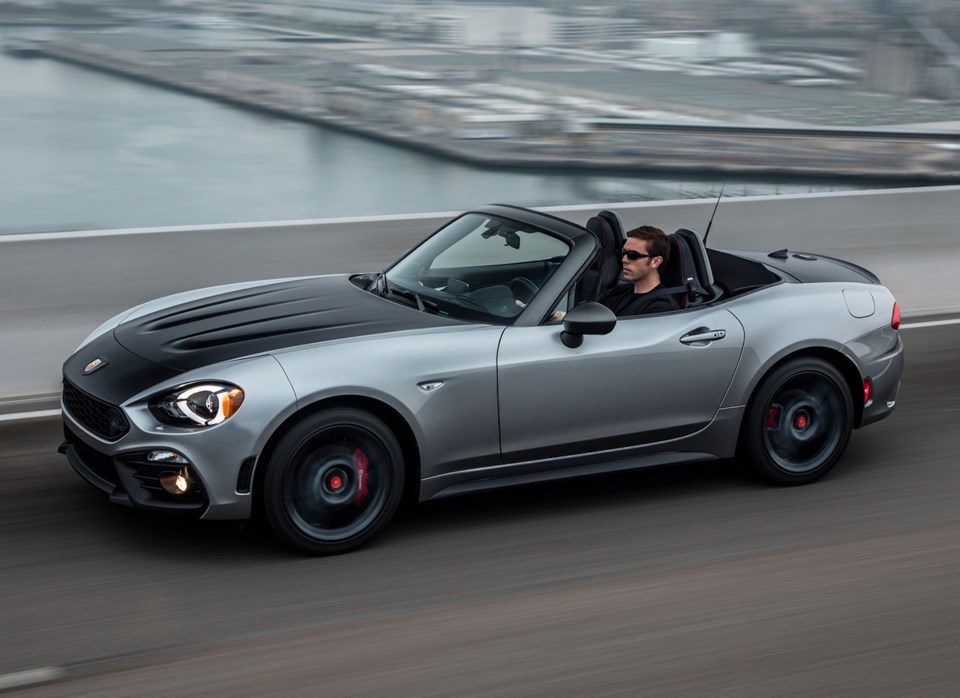The 2018 Fiat 124 Spider pays homage to the original 124 Spider, introduced 50 years ago and revived for 2017, with classic Italian styling and performance.
The ultimate Italian roadster experience is a combination of technology and safety, with driving excitement and iconic design. The current 124 Spider reinterprets design cues from the original, one of Fiat’s most beautiful cars, with a low-slung profile, classically beautiful body sides, balanced proportions and sporty cabin-to-hood ratio.
Three models are available –– the bare-bones Classica ($35,390), the more-comprehensively equipped Lusso ($36,495) and, for performance enthusiasts, the aggressive Abarth ($37,995) –– the most affordable turbo-powered convertible in North America.
All models come standard with a MultiAir Turbo 1.4-litre four-cylinder engine with twin intercoolers and an air intake; the engine’s first application in a rear-wheel-drive vehicle, producing best-in-class 160 horsepower in the Classica and Lusso, and 164 hp in the Abarth. A six-speed manual transmission or an optional six-speed automatic sends power to the rear wheels.
My 124 Spider Abarth was Grigio Chiaro with red-stitched Nero Black leather and microfibre sport seats, fitted with the six-speed automatic transmission, riding on 17-inch Gun Metallic aluminum wheels with three-season performance tires.
The optional Brembo brakes peeked through the five V-shaped spokes. Gunmetal exterior accents (rearview mirrors, headlight and daytime-running-light housings) added sportiness, along with unique aggressive-looking front and rear fascia. Wide rectangular LED taillights were easy to see.
Abarth shields punctuated the trunk lid and the middle of the creased hood, with smaller representations in red on the wheel hub covers. Abarth is an Italian racing- and road-car manufacturer founded by Carlo Abarth. The shield shows a black stylized scorpion on a yellow and red background. A hand-painted Heritage Racing Stripe is available for $1,995.
A performance-tuned suspension (specifically tuned for greater stability during braking and turning), limited-slip differential, and a driving mode selector with Sport and Normal modes were standard. A sport-tuned exhaust with four dark-chrome tips added the world-renowned Abarth sound.
Choosing the automatic transmission added $1,495, and included a leather-wrapped shift knob and steering wheel paddle shifters. The transmission provided smooth full-throttle launches and quick upshifts and downshifts, delivering a more-direct feel in response to acceleration.
Getting in was a challenge, as the sill was tall and wide and the roof (in the up position, of course — it is winter) was low. The interior of the 124 Spider is small — it is a roadster — and the seats are narrow with bolstering that could be uncomfortable for larger passengers. A small armrest with a covered cubby and a storage spot for a phone divides the seats, and a glovebox cubby is large enough for a small or medium-size purse and a few other things between the seatbacks.
Movable cup holders could be positioned on the front sides of the centre console (near the knees) or the back of the console (behind the elbows, in front of the glovebox — not very convenient). Speakers integrated into the headrests were a little tinny.
The standard audio system was AM/FM/Bluetooth with Pandora, Aha, and Stitcher apps, a seven-inch display, and four speakers. Bluetooth was capable of displaying incoming text and email messages. The system did not, however, include Android Auto or Apple CarPlay capability. The system was nav-capable, although my 124 Spider didn’t have nav. Two USB ports meant that passenger and driver could each charge a device.
The heated seats were set low, an appropriate driving position for a roadster, and had recline and fore-and-aft adjustments. As room for adjustments was limited, one could choose to recline or move fully aft for long legs, not both at once. Room for the passenger was slightly claustrophobic, with a low, thick windshield frame and a wide transmission tunnel intruding on the passenger-side floor space.
Visibility through the front was good and the rearview mirror was above average for a roadster, thanks to the low, sloping rear deck. Due to the wide rear supports of the cloth roof, rear three-quarter visibility was severely limited. An optional Comfort and Convenience Group brought blind-spot and cross-path detection to cover that area.
The package also had ParkSense Rear Park Assist, heated exterior mirrors, auto-dimming rearview mirror, universal garage door opener, and a security alarm. A standard ParkView rear backup camera also helped when backing from a parking space.
Bumps and dips were felt, as expected in a roadster, with smaller imperfections well absorbed. Irregular road surfaces or seams caused a slight rocking effect due to the short wheelbase.
Also as expected in a cloth-top convertible, some road and wind noise were noticeable, depending on road conditions. My Abarth had an acoustic headliner to help absorb some of that noise. The manual top was exceptionally easy to use by releasing a handle at the front edge and pulling.
Climate control knobs were simple and easy to reach. Infotainment knobs were also close, clearly marked and easy to use. The sport instrument cluster had a large tachometer in the center, flanked by the speedometer and gas and temperature gauges.
Abarth’s trunk was small, as expected, but low to the ground for an easy liftover. I managed to stuff lots of groceries and cat supplies in, although luggage for a long road trip would not be possible or comfortable.
The diminutive 124 Spider Abarth was fun to drive, and could manage zero to 100 kilometres an hour in 6.6 seconds. Once up to highway speed, overtaking was quick and easy.
Handling was nimble, even darty at highway speeds, with minimal body roll in turns. Braking was firm and straight.
My Abarth was rated for 25 mpg city/36 highway, and I managed 32.4 mpg driving mostly on the highway.



